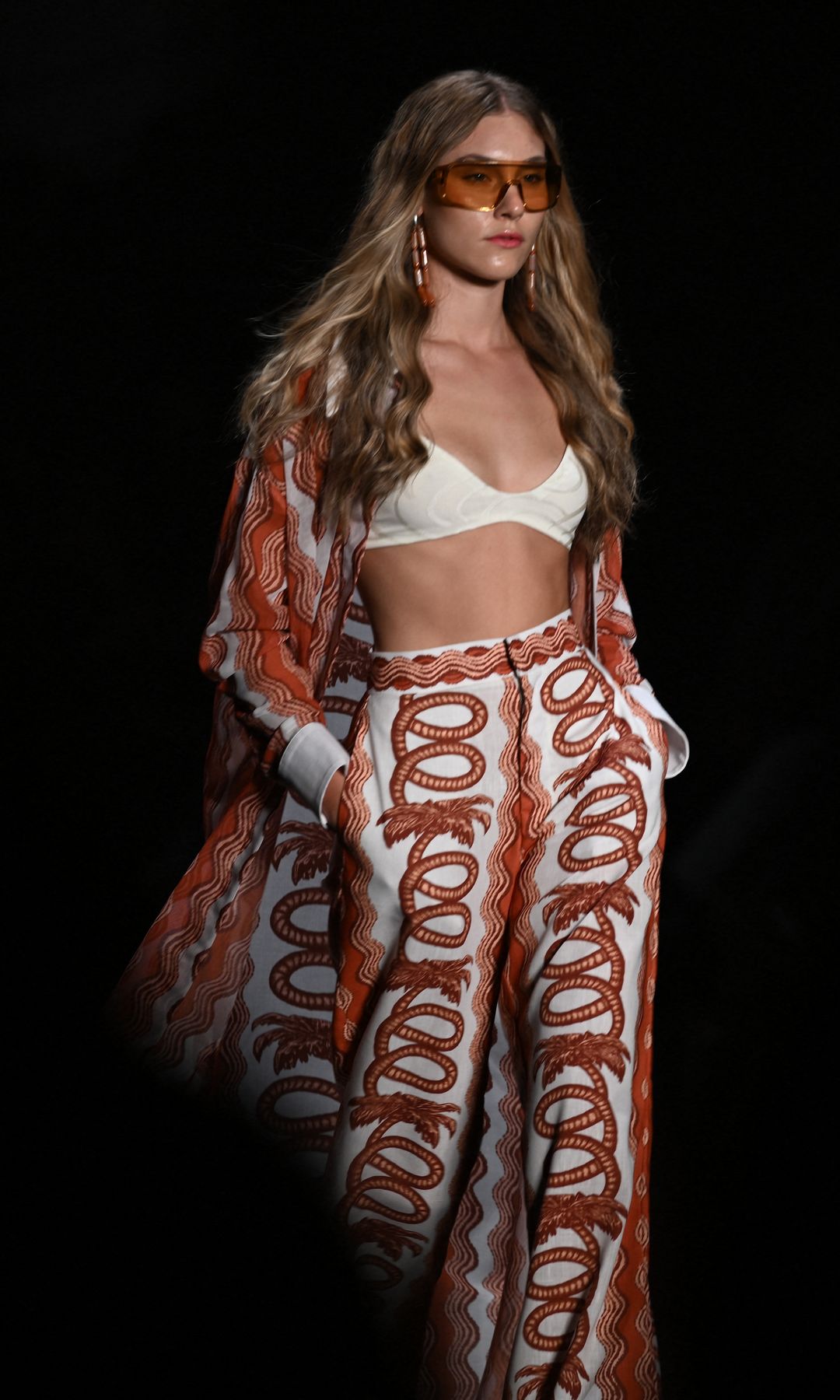Luxury fashion: for some, it’s the exclusivity of haute couture – one-of-a-kind pieces meticulously crafted with unparalleled detail. For others, it’s about heritage and craftsmanship, the touch of the finest cashmere or the weight of a draped silk gown. From subtle tailoring that speaks softly to bold branding and statement monograms, the spectrum is as vast as it is refined.
Bar New York, the concept of sartorial luxury is typically defined by a Eurocentric perspective. European fashion capitals are the style world’s reigning cliques – exclusive, influential, and perpetually setting the trends. Paris, Milan and London have long dictated global fashion narratives, but the scene is slowly evolving. Cities like Seoul, Shanghai, Lagos, Copenhagen, and Tbilisi are emerging as formidable players, each infusing their unique cultural flair into the industry.
One pan-Atlantic creative hub in particular continues to fly under the radar, only recently starting to gain traction in the mainstream fashion sphere. Colombia has long been the quiet home of artisanal craft, a niche vein of luxury that isn’t about loud logos or fleeting trends.
Craftsmanship runs deep within the country’s DNA. “We always stay true to our Latin roots,” says designer Johanna Ortiz. “Our work is a tribute to exquisite design, craftsmanship, and the power of women, all driven by a vision of a better world. We collaborate with twenty-three Colombian communities to preserve and showcase these traditions on a global stage, fostering social inclusion and local development. By fusing heritage craftsmanship with contemporary fashion, we create designs that honour our culture while empowering women to embrace their individuality.”
This concept is collectively understood by Colombian creatives. “The intersection between fashion and craftsmanship has become a distinguishing feature of Colombian fashion,” notes Colombian fashion journalist Adrián Osorio. “The ability of designers to collaborate with artisanal and Indigenous communities, preserving ancestral knowledge, is something to be applauded and further encouraged.”
The country’s rich creative history played a crucial role in shaping its fashionscape. Colombian fashion is a vibrant blend of rich cultural heritage, where traditional indigenous garments meet the refined designs of mestizo influence. Designers like Johanna Ortiz helped to reshape the identity of the fashion industry, exemplified by her ‘Caribbean Chic’ aesthetic introduced in 2014. The designer’s vision combined tropical motifs with meticulous craftsmanship, drawing on Colombia’s diverse cultural roots and climate with a modern spin. Fellow designers Silvia Tcherassi and Esteban Cortázar also successfully tapped into and championed the style.
Colombia’s fashion legacy is built on high-quality textiles. In the late 1980s, a cotton boom transformed the nation’s textile industry, sparking the need for an institute to track emerging trends. This led to the establishment of INEXMODA, which has since played a pivotal role in launching Colombiamoda, Colombia’s Fashion Week. Additionally, the Bogotá Chamber of Commerce, instrumental in running Bogotá Fashion Week, was set up further cementing the country’s reputation on the global fashion stage.
“The textile industry in Colombia has been part of the country’s history, even before there was talk of a Colombian fashion industry,” Osorio continues. “It remains a pillar of the national economy. This sector has gained recognition for its innovation, skilled workforce, creativity, high-quality materials, and diversification.”
For those who associate luxury with top-notch quality as opposed to designer stamps, then Colombia should be on your radar. Colombia’s distinctive standing as the world’s second most biodiverse nation stands as a badge of honour. Materials such as organic cotton, linen and cabuya and natural dyes promise planet-friendly alternatives to polluting synthetic materials. One shining example of the country’s creativity came in 2018. Students from Universidad de los Andes in Bogotá developed a fabric called Woocoa, which blends coconut fibres and waste from the medical marijuana industry to create a biodegradable alternative to traditional wool. The invention secured the PETA Prize for Animal-Free Wool at the 2018 Biodesign Challenge, which was sponsored by Stella McCartney.
This innovative flair can be seen in the work of designers such as Waimari, whose collections are handcrafted by Colombian artisans (typically single mothers or the breadwinners of the family) in the brand’s factory.
“We are not a static brand,” says co-founder Stephanie Martinez. “While we emphasise luxury and high fashion through artisanal craftsmanship, we bring a specific sense of Colombian celebration to the international stage – respectful, yet impossible to overlook. We are a brand for people who want to project the joy of our land with confidence and respect.”
She adds: “Nowhere else in the world do flora, fauna, and sociocultural values coexist the way they do in Colombia and that uniqueness is reflected in our fashion. It’s a luxury to be Colombian, and we wear that proudly.”
The joyousness of Colombian design shines through, perhaps a response to the nation’s turbulent social climate that craves a moment of escapism. Colombia’s 20th century history was marked by internal conflict, political instability, and economic development, including periods of civil war, the rise of guerrilla groups, and the emergence of the drug trade. “Our troubled history makes us unique in how we look at life and how we can tell our own stories. Art can be a tool for healing from trauma,” says Jennifer Droguett, founder of Colombian brand Anciela. “I left Colombia when I was 10 years old in the 2000s because of the violence, but I have seen positive change every time I go back.”
Despite the challenges faced by Colombian’s fashion industry, the country’s sartorial talent has still retained its grasp on the wardrobe of style pioneers. Last summer, the Duke and Duchess of Sussex embarked on a four-day tour of the South American country, invited courtesy of vice-president Francia Marquez. Meghan championed homegrown brands such as Johanna Ortiz, Andres Otalora, and Aquazurra, propelling Colombian design onto the international stage.
The duchess isn’t the only style insider to publicly champion Colombian creativity. Jennifer Lopez, Hailey Bieber, Emma Roberts and Eva Mendes have all been spotted in botanical pieces by Agua By Agua Benita, a brand born in the city of Medellín. Likewise Haider Ackermann, the Bogotá-born creative director of Tom Ford, has worked closely with Timothée Chalamet, Cate Blanchett, Michelle Williams and Gigi Hadid since joining the house in September 2024. Although adopted by a French family and spending little time in Colombia, Haider Ackermann credits the country’s vivid colours and rich cultural contrasts as lasting influences on his design aesthetic, shaped further by his nomadic upbringing through his father’s work as a cartographer.
With its nature-inspired joie de vivre, the question remains: how can Colombia’s intimate luxury truly make its mark on a worldwide level? Amid the ongoing fast fashion crisis, the climate emergency, and the continued exploitation of human rights within the fashion industry, it’s clear that the world urgently needs a dose of Colombian innovation.
“The key is to stay true to our identity while embracing creativity, Ortiz says. “By fostering artisanal craftsmanship, investing in sustainability, and telling our unique stories, we can make a lasting impact. We will continue to gain recognition and influence through strong, coherent design proposals and exceptional products that can be showcased and appreciated on the global stage.”
Colombia is quietly redefining luxury with a logoless, craft-driven approach. As local designers begin to make waves across Europe, it’s only a matter of time before the country’s rich artistic flair captivates the international spotlight.
Colombia’s luxury revolution began years ago – and now, it’s poised to challenge our perceptions of true luxury and leave a lasting global impact.
Read the full article here










